Project Subtitle:
Project Description:
HELIOS is the architect's own home which evolved over time from a passive solar home, to a home which also reduced its hot water needs, to a home with reduced heating and cooling energy loads, and finally to a net zero energy home. Helios was first constructed in 1984 as a passive solar home with the intent of employing proper building orientation, partial earth sheltering, solar gain through a two story sunspace and south facing windows, and building mass to reduce the heating load in rural northwestern New Jersey. This design resulted in a home which consumed only 35% of the energy needed for space heating a comparable conventional home. In 1998 a solar hot water system was added to provide 65% of the hot water needs. With the advent of high efficiency mini-ductless split-system heat pumps, this equipment was installed over time to replace the existing heating systems in the home. When solar photovoltaic (PV) systems became more affordable in 2008, a 4.7 KW (DC) system was installed, and with further economies in solar PV an additional 4.1 KW (DC) system was installed in 2015. The result is a net-zero energy home which has been carefully monitored over a full year of actual use to verify that all energy for space heating, cooling, hot water, and plug loads is provided by solar energy. The only energy not yet covered is the electricity needed to charge the owner's electric car. When community solar is permitted in New Jersey the owner plans to purchase the necessary energy from a community system to also satisfy the electric vehicle.
Building Type Summary:
Address:
Elevation:
Lat. / Long.:
Location Type:
Köppen Climate Type:
Climate Region:
Solar Insolation:
Annual HDD :
Annual CDD:
HDD Base Temp:
CDD Base Temp:
Occupancy Type and Details:
Owner occupied private home, currently with 2 full time residents plus visitors on weekends. With home office one resident is there 5 days per week 9am to 5pm.
Conditioned Floor Area:
Conditioned Building Volume:
Unconditioned Floor Area:
Multiple buildings?:
Total number of units in project (all buildings):
Total floor area of project (all buildings):
Historic?:
Completion date:
Site description:
South facing elevated hilltop 4.25 acre wooded lot with a view to the south over farmland in the valley. The shale at the building site was excavated so the rear (north side) of the home is earth sheltered - two stories high, while the front (south side) of the home is open to final grade. Trees were removed to provide solar access to all south facing glass.
Materials:
Mass walls and floors are exposed poured concrete (painted a dark color). Interior walls are mostly cedar and redwood (with minimum use of gypsum board on walls). Ceilings on all floors are exposed spruce-pine-fir tongue and groove wood decking. Exterior masonry and wood stud walls are covered with EIFS acrylic stucco finish. Landscaping is natural native plant gardens, existing oak and maple trees, with a small lawn area on the south side (over septic system).
Energy Highlights:
HELIOS includes passive solar design strategies for maximizing solar space heating (two-story sunspace plus direct gain to mass floors and walls, and earth-sheltering), and a solar hot water system supplemented by a heat pump water heater, plus high efficiency mini-ductless split system heat pumps (operable to -15 deg. F.), and a 9 KW solar PV system which takes care of all electrical needs. This combination of energy strategies results in a Net-Zero Energy home based on actual use over a one year period.
Annual renewable energy generated:
Electric Utility Company:
Gas Utility Company:
Datasets and Utility Bills sources and reliability:
Utility bills from Sussex Rural Electric Coop are compared monthly with the actual meter readings.
Electricity amount (imported from grid):
Electricity amount (credited or exported to grid):
Net electricity usage (purchased electricity):
Natural gas amount (purchased energy):
Energy Storage type:
Solar produced electrical energy is not stored, but solar hot water production is stored in an 80 gal. storage tank which is supplemented by a new heat pump water heater. For space heating, the passive solar direct gain is stored daily in the mass floors and walls (insulated on the outside).
Subslab assembly:
4" concrete slab over 4" XPS insulation over 6 mil polyethylene vapor barrier
Slab edge assembly:
1-1/2" EPS insulation over edge of 4" concrete slab
Foundation wall assembly:
1-1/2" EPS exterior over 8" concrete block
Above grade wall assembly:
2x6 stud walls at 16" on center with fiberglass blanket insulation plus 1-1/2" rigid EPS exterior. In addition north wall is poured concrete retaining wall with 2" XPS insulation towards earth side and open to interior (painted dark color to serve as mass wall to store solar heat gain in winter).
Flat attic assembly:
Entire ceiling is cathedral
Cathedral ceiling assembly:
Asphalt shingles over nailbase polyiso insulation boards 4.5" thick, with 1-1/2" tongue and groove wood decking exposed inside.
Door Area:
Space heating - Manufacturer & Model:
Space heating - capacity:
Domestic hot water - Manufacturer & Model:
Domestic hot water - capacity:
Domestic hot water - efficiency:
Process:
The architect designed his own home in 1983 to be a passive solar home providing up to 65% of space heating. The design included orientation of all rooms to the south, a 2 story sunspace to act as a buffer to the conditioned spaces, and earth sheltering to the north. Heating performance was monitored for several years and energy modelling (using Energy 10) substantiated a 65% benefit over a conventional home in the same location. Later solar hot water system was added and monitored to demonstrate that two-thirds of the home's hot water needs were provided by solar. Finally solar photovoltaic systems were added to the design with mounting on flat and sloping surfaces of the original roof planes to provide a 9.4 KW (AC) system.
Energy Modeling Software:
Originally "Energy 10" was used to model the original passive solar design with conventional heating and cooling systems. Later "BeOpt" (EnergyPlus is simulation engine) was used to model the home retrofitted with heat pumps and solar systems.
Outcome of project goals:
1. Earth sheltering is very helpful to reduce heat loss and infiltration (but humidity needs to be controlled).
2. A two-story sunspace with vertical glass is an excellent buffer for conditioned spaces of the home.
3. Mass floors and walls work well to stabilize indoor temperatures in winter and summer.
4. A solar hot water system with a heat pump water heater as backup works very well to provide all hot water needs.
5. A solar PV system (with micro inverters in locations with some trees) can provide all the power needed to achieve a net zero energy home.
6. Decentralized heating and cooling utilizing mini ductless split system heat pumps is an excellent way to achieve high efficiency.
Discrepancies:
The energy models predicted higher performance than actually achieved. Since this home was originally constructed in 1984 some materials were not as efficient, and air leakage has diminished the expected building performance.
Finances Description:
The home was constructed by the architect/owner using subcontractors over a long period of time. Original costs were from 1984 and don't relate to current construction costs. Recent solar installations matched average costs in the New Jersey area.
Gross Cost of Renewable Energy System:
Value of Tax Credits for renewable energy systems:
Net Cost of renewable energy systems:
Federal incentives:
Federal Tax Credit - 30%
State incentives:
No sales tax
Local incentives:
No property tax
Annual Electric Savings:
Annual Revenue from SRECs or other renewable energy credits:
Published References:
"Solar Today" magazine cover - Sept.-Oct. 2014 issue - http://www.omagdigital.com/publication/?i=224882
"Energy Sage" web page - https://www.energysage.com/project/6238/helios-zero-net-energy-home-in-l...
Special architectural measures:
The home was originally constructed in 1984 as a passive solar design to maximize solar gain for space heating. The two story sunspace is unheated and acts as a buffer to the conditioned spaces behind. The north side of the home is earth sheltered (concrete wall with insulation on exterior) and the interior of the exposed concrete wall acts as a mass wall to store solar heat in the winter. Roof overhangs protect from overheating in the summer months. The solar heating performance was carefully monitored and calculated to be 65% better than a similar size conventional home in this location.
Energy Strategies:
HELIOS uses no fossil fuels (except for cooking), includes passive solar design strategies for maximizing solar space heating , and a solar hot water system supplemented by a heat pump water heater, plus high efficiency mini-ductless split system heat pumps (operable to -15 deg. F.), and a 9 KW solar PV system which takes care of all of the home's electrical needs. This combination of energy strategies results in a Net-Zero Energy home based on actual use over the most recent one year period.
Energy Use and Production Documentation:
Subslab R-value:
Slab edge R-value:
Foundation wall R-value:
Above grade wall R-value:
Flat attic R-value:
Cathedral ceiling R-value:
Average window U-factor:
Solar Heat Gain Coefficient:
Visible Light Transmittance:
Door U-Factor:
Air Changes per hour, ACH50:
Project Photos:
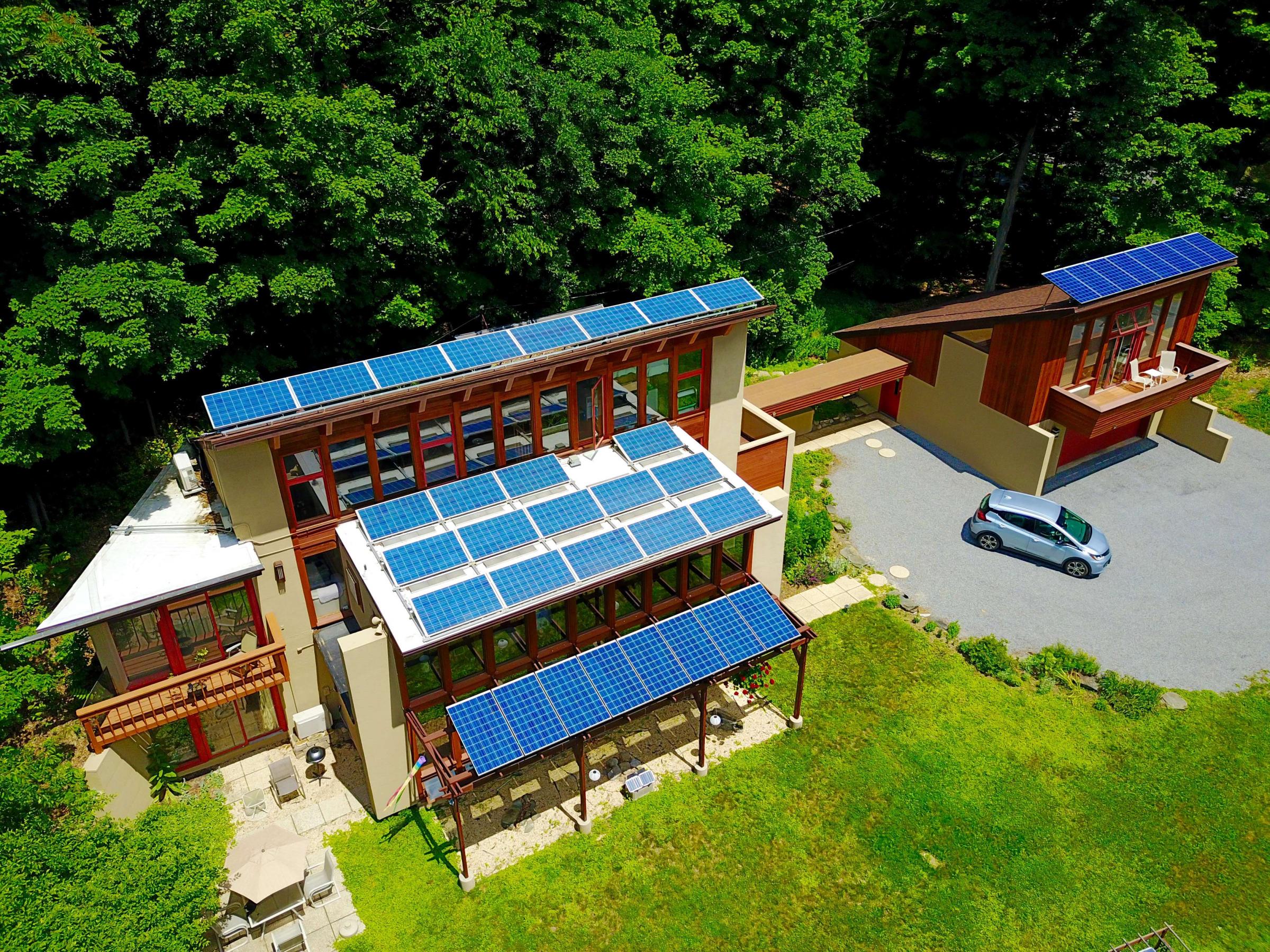
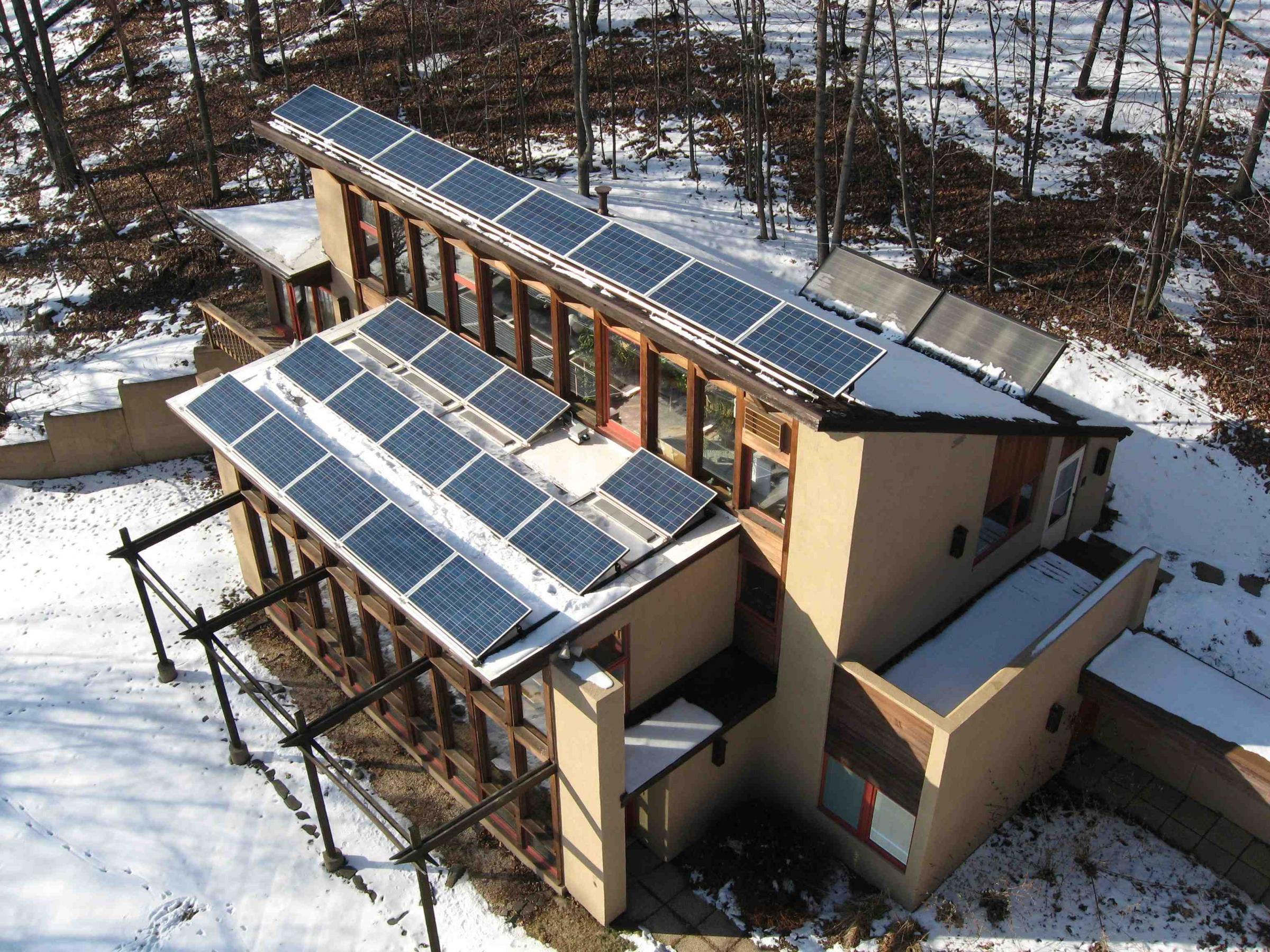
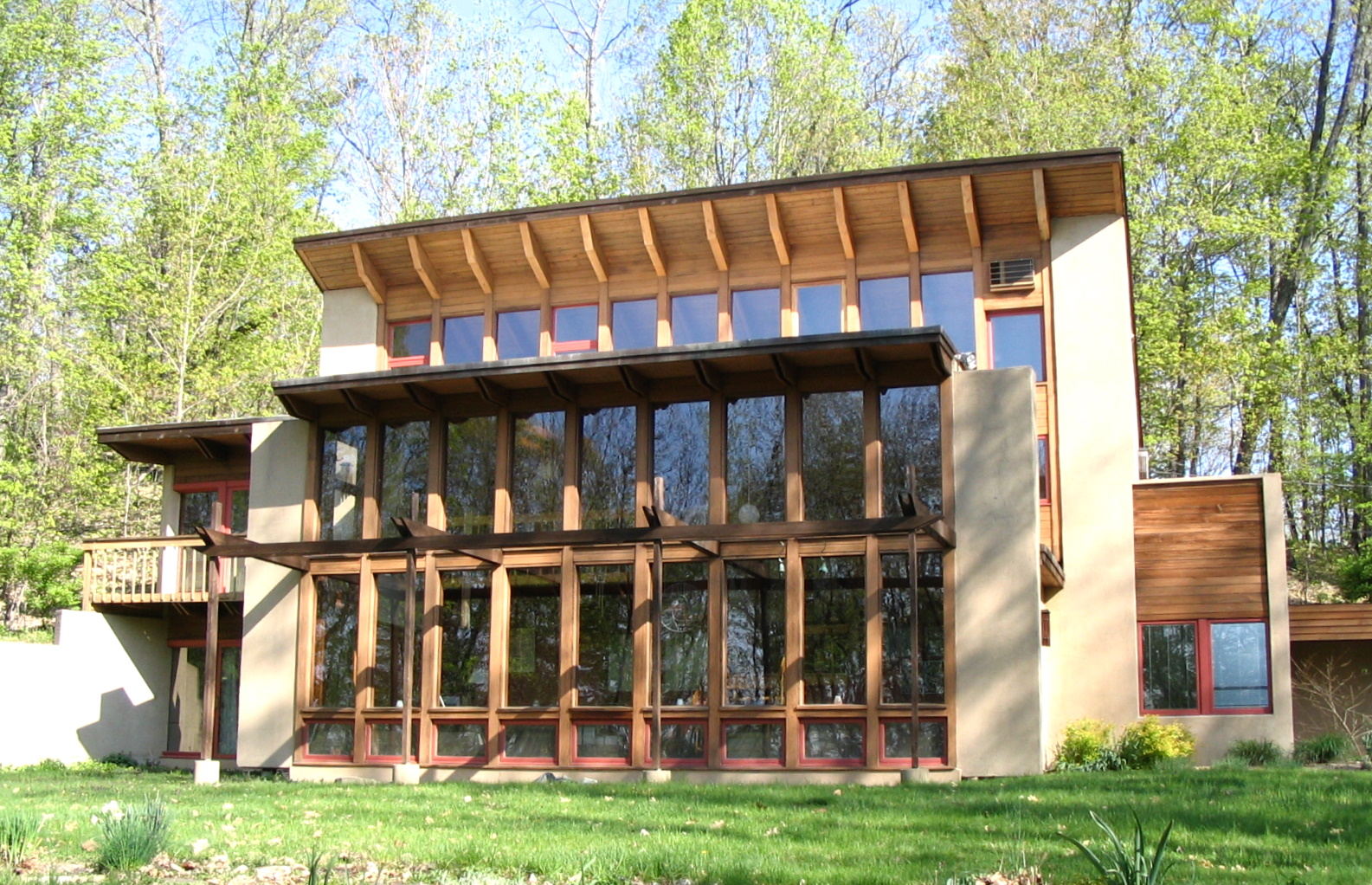
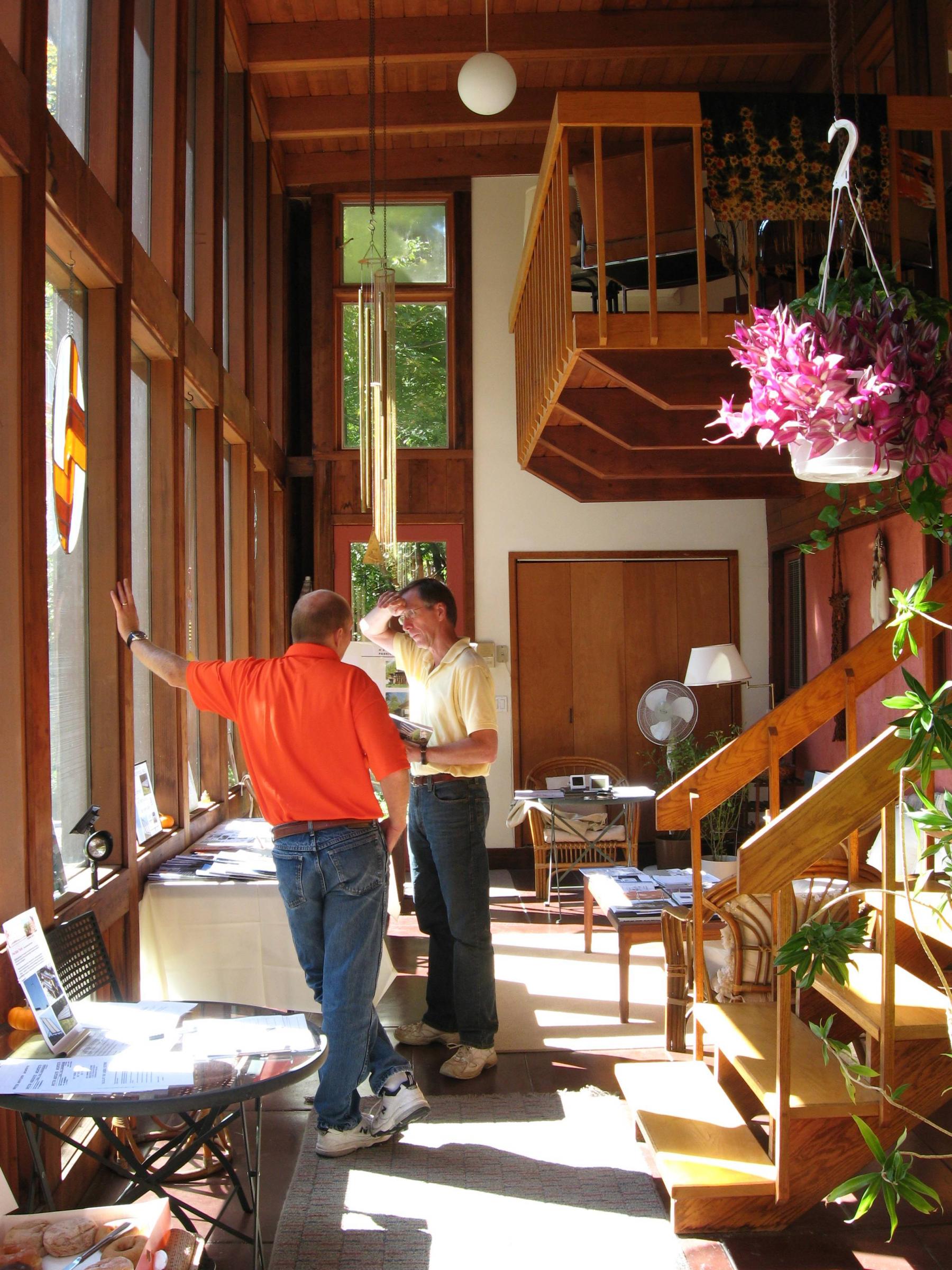
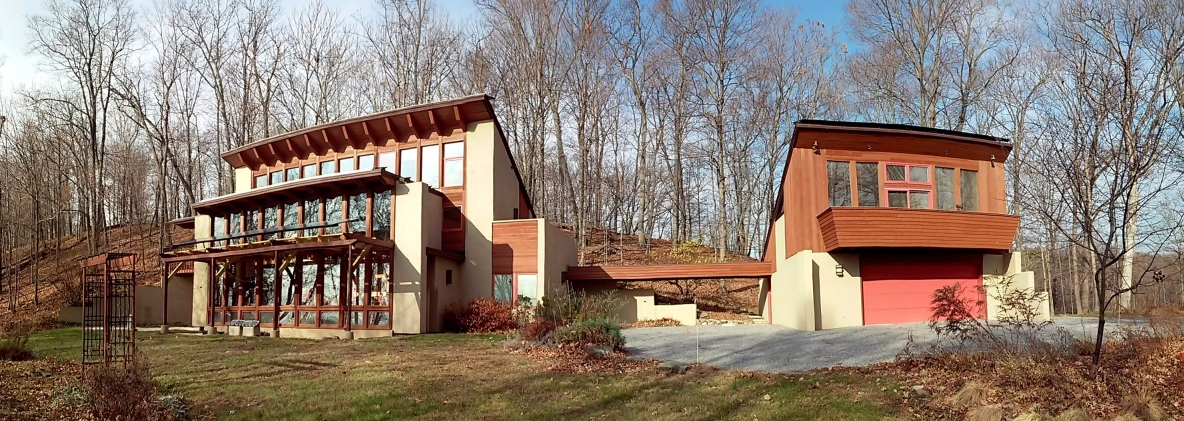
Number of Bathrooms:
Site conditions:
Renewable Energy Sources:
Other Purchased Fuels Description:
None
Storage Strategies & System Details:
Hot water storage appears to carry over for several days during the spring and summer, but is quickly dissipated in fall and winter (based on solar hot water monitor readings). Solar space heating in winter months is stored in mass walls and floors until early evening when there is full sun. Based on 32 years of observation, on a cold January day (20 deg. F. outside) with full sun, supplementary space heating in the living rooms is not needed until about 6pm.
Summary of enclosure strategy/description:
Roof insulation is rigid 4.5" thick nailbase polyiso insulation over exposed wood decking. Frame walls are 1-1/2" rigid insulation & EIFS system over 2x6 studs @ 16" on center with 5-1/2" fiberglass blanket insulation. Rear exterior wall is 2" XPS insulation over 8 to 12" thick poured concrete retaining wall, forming earth-sheltered north wall of home. South facade has a 30' wide x 2 story high sunspace which buffers the home from outside winter weather conditions. Three foot roof overhangs provide shading for summer sun, but allow full sun to enter in winter for passive solar gain.
Roof Assembly:
Asphalt shingles over nailbase polyiso insulation boards 4.5" thick, with 1-1/2" tongue and groove wood decking exposed inside.
Roof R-value:
Window Description:
Painted wood frame Andersen casement and awning and fixed window units originally installed in 1984, with 5/8" thick insulating glass.
Door Description:
ThermaTru insulating core door with vision panel
Number of Bedrooms:
Project Team:
Team Member:
Team Members:
Charles Cohn, PE
Energy Modeling of Passive Solar Systems
Kurt Gewecke
KG Solar
Design & installation of solar PV systems

Mechanical Equipment Installation Details and Comments:
Heat pump units replaced older propane heaters and standard air conditioners from original home construction. Heat pumps installed per manufacturer's specifications.